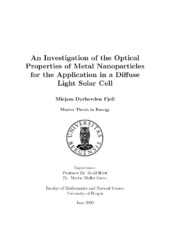| dc.description.abstract | The need of renewable energy is increasing as the global energy demand increases concurrently with greenhouse gas emissions from energy use. According to the International Energy Agency, the energy demand will rise by 1.3 % every year to 2040, and more and more energy will be delivered from electricity. The electrical power sector is the single largest source of carbon emissions, hence the share of renewables in the electricity generation needs to be increased. Photovoltaic solar cells convert solar radiation directly into electricity and are expected to play an important role in the electricity production in the coming years. However, the efficiency of today’s commercial silicon solar cells, which dominate the solar cell installations today, is only about 20 % and is highly dependent on the intensity of the incoming solar radiation. Under diffuse light conditions, the intensity of the incoming solar radiation is decreased, and efficient light incoupling is therefore of paramount importance to make solar cells an alternative in areas where diffuse light conditions dominate. In this thesis work, sustainable solutions using plasmonic metal nanoparticles to increase the light incoupling in silicon solar cells over a broad angular range, corresponding to diffuse light conditions, have been investigated. Through numerical simulations using an FDTD solver, it has been found that the introduction of spherical aluminum nanoparticles with a 3 nm oxide layer of diameter 120 nm in a periodic array with period 360 nm on top of flat silicon solar cells can enhance the transmission of light by 7.46 % over all incident light angles. This leads to an overall increase in the solar cell efficiency of 1.71 %, or a relative increase of 7.23 %. Aluminum is the 7th most abundant material on Earth and also cheap with respect to material price, making it realistic that it can be used in large scale solar cell production. | en_US |
